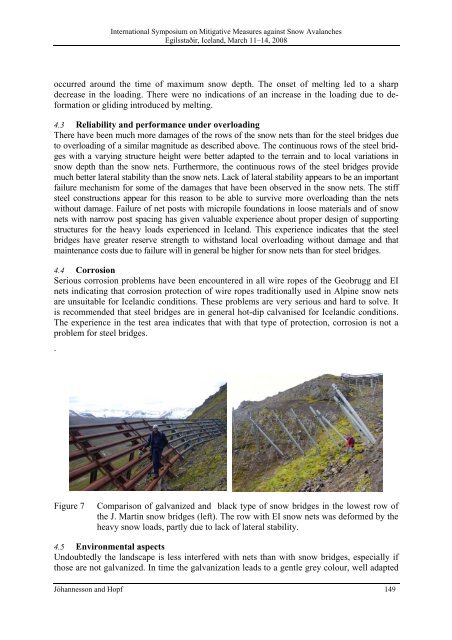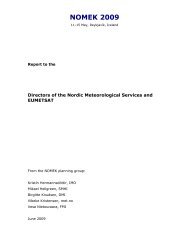International Symposium on Mitigative Measures against Snow ...
International Symposium on Mitigative Measures against Snow ...
International Symposium on Mitigative Measures against Snow ...
Create successful ePaper yourself
Turn your PDF publications into a flip-book with our unique Google optimized e-Paper software.
<str<strong>on</strong>g>Internati<strong>on</strong>al</str<strong>on</strong>g> <str<strong>on</strong>g>Symposium</str<strong>on</strong>g> <strong>on</strong> <strong>Mitigative</strong> <strong>Measures</strong> <strong>against</strong> <strong>Snow</strong> Avalanches<br />
Egilsstaðir, Iceland, March 11–14, 2008<br />
occurred around the time of maximum snow depth. The <strong>on</strong>set of melting led to a sharp<br />
decrease in the loading. There were no indicati<strong>on</strong>s of an increase in the loading due to deformati<strong>on</strong><br />
or gliding introduced by melting.<br />
4.3 Reliability and performance under overloading<br />
There have been much more damages of the rows of the snow nets than for the steel bridges due<br />
to overloading of a similar magnitude as described above. The c<strong>on</strong>tinuous rows of the steel bridges<br />
with a varying structure height were better adapted to the terrain and to local variati<strong>on</strong>s in<br />
snow depth than the snow nets. Furthermore, the c<strong>on</strong>tinuous rows of the steel bridges provide<br />
much better lateral stability than the snow nets. Lack of lateral stability appears to be an important<br />
failure mechanism for some of the damages that have been observed in the snow nets. The stiff<br />
steel c<strong>on</strong>structi<strong>on</strong>s appear for this reas<strong>on</strong> to be able to survive more overloading than the nets<br />
without damage. Failure of net posts with micropile foundati<strong>on</strong>s in loose materials and of snow<br />
nets with narrow post spacing has given valuable experience about proper design of supporting<br />
structures for the heavy loads experienced in Iceland. This experience indicates that the steel<br />
bridges have greater reserve strength to withstand local overloading without damage and that<br />
maintenance costs due to failure will in general be higher for snow nets than for steel bridges.<br />
4.4 Corrosi<strong>on</strong><br />
Serious corrosi<strong>on</strong> problems have been encountered in all wire ropes of the Geobrugg and EI<br />
nets indicating that corrosi<strong>on</strong> protecti<strong>on</strong> of wire ropes traditi<strong>on</strong>ally used in Alpine snow nets<br />
are unsuitable for Icelandic c<strong>on</strong>diti<strong>on</strong>s. These problems are very serious and hard to solve. It<br />
is recommended that steel bridges are in general hot-dip calvanised for Icelandic c<strong>on</strong>diti<strong>on</strong>s.<br />
The experience in the test area indicates that with that type of protecti<strong>on</strong>, corrosi<strong>on</strong> is not a<br />
problem for steel bridges.<br />
.<br />
Figure 7 Comparis<strong>on</strong> of galvanized and black type of snow bridges in the lowest row of<br />
the J. Martin snow bridges (left). The row with EI snow nets was deformed by the<br />
heavy snow loads, partly due to lack of lateral stability.<br />
4.5 Envir<strong>on</strong>mental aspects<br />
Undoubtedly the landscape is less interfered with nets than with snow bridges, especially if<br />
those are not galvanized. In time the galvanizati<strong>on</strong> leads to a gentle grey colour, well adapted<br />
Jóhanness<strong>on</strong> and Hopf 149











